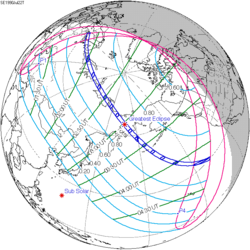| Total eclipse | |
| Gamma | −0.887 |
|---|---|
| Magnitude | 1.0591 |
| Maximum eclipse | |
| Duration | 259 s (4 min 19 s) |
| Coordinates | 42°30′S119°24′W / 42.5°S 119.4°W |
| Max. width of band | 414 km (257 mi) |
| Times (UTC) | |
| Greatest eclipse | 21:55:20 |
| References | |
| Saros | 117 (62 of 71) |
| Catalog # (SE5000) | 9262 |
A total solar eclipse occurred at the Moon's ascending node of orbit on Tuesday, April 26, 1892, with a magnitude of 1.0591. A solar eclipse occurs when the Moon passes between Earth and the Sun, thereby totally or partly obscuring the image of the Sun for a viewer on Earth. A total solar eclipse occurs when the Moon's apparent diameter is larger than the Sun's, blocking all direct sunlight, turning day into darkness. Totality occurs in a narrow path across Earth's surface, with the partial solar eclipse visible over a surrounding region thousands of kilometres wide. Occurring only about 13 hours after perigee (on April 26, 1892, at 9:10 UTC), the Moon's apparent diameter was larger. [1]





























































































